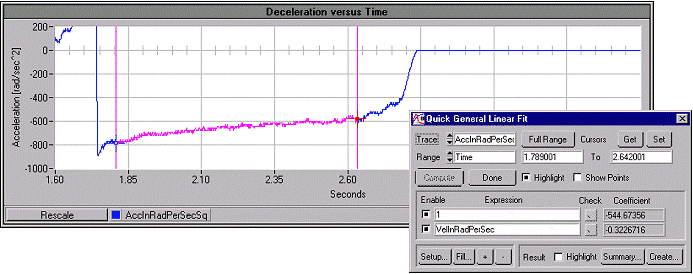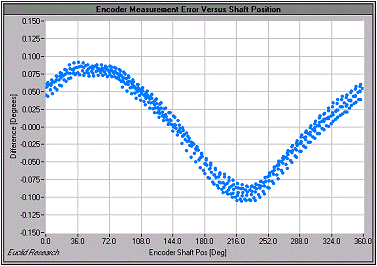
 | Simple Measurements of an Encoder |
Below are some simple measurements performed on an encoder. The encoder being evaluated was a 500 PPR encoder with an inertia of 1.0e-4 oz-in-sec2
Encoder Friction
The viscous friction of the encoder was quickly estimated using the generalized linear fit tool of SensorPlot™. In this experiment, the encoder was spun to a velocity of 6000 RPM and allowed to coast to a stop under influence of friction. The measured acceleration (shown in the graph below) was fit (in the highlighted region) with an equation that was a function of encoder shaft velocity.

The fit result for acceleration is given below as well as the corresponding friction torque as a function of encoder shaft velocity:
| Acceleration: | Acceleration(EncoderVelocity) | = -544 - 0.323 * EncoderVelocity |
| Friction Torque: | Tf(EncoderVelocity) | = Inertia * Acceleration(EncoderVelocity) |
| = ( -0.054 - 32.3e-6 * EncoderVelocity ) [oz -in] |
Encoder Measurement Errors Analyzed Over One Revolution:
 The graph to the right illustrates the position measurement error of the encoder plotted over one revolution. The test was performed by attaching an inertia to the encoder, ramping the encoder to some velocity then allowing the encoder to coast down under the influence of friction. The position, as measured by the encoder, was subtracted from an ideal position trace and the result was plotted versus shaft position modulo one revolution. The ideal position was computed by double integrating a fit of acceleration (fit using the same method as in the example above for friction). Notice how the error repeats from one revolution to the next.
The graph to the right illustrates the position measurement error of the encoder plotted over one revolution. The test was performed by attaching an inertia to the encoder, ramping the encoder to some velocity then allowing the encoder to coast down under the influence of friction. The position, as measured by the encoder, was subtracted from an ideal position trace and the result was plotted versus shaft position modulo one revolution. The ideal position was computed by double integrating a fit of acceleration (fit using the same method as in the example above for friction). Notice how the error repeats from one revolution to the next.
This test could have also been performed by connecting a higher resolution encoder to the encoder under test and measuring both encoders simultaneously with SensorPlot™. The higher resolution encoder would simply be used to provide a measured ideal shaft position.
Euclid Research · 2 North 1st Street, 6th Floor · San Jose, CA 95113-1201
Tel: (408) 283-9020 · Fax: (408) 283-9029